AWS Statistics And Facts (2025)
Updated · Sep 06, 2025
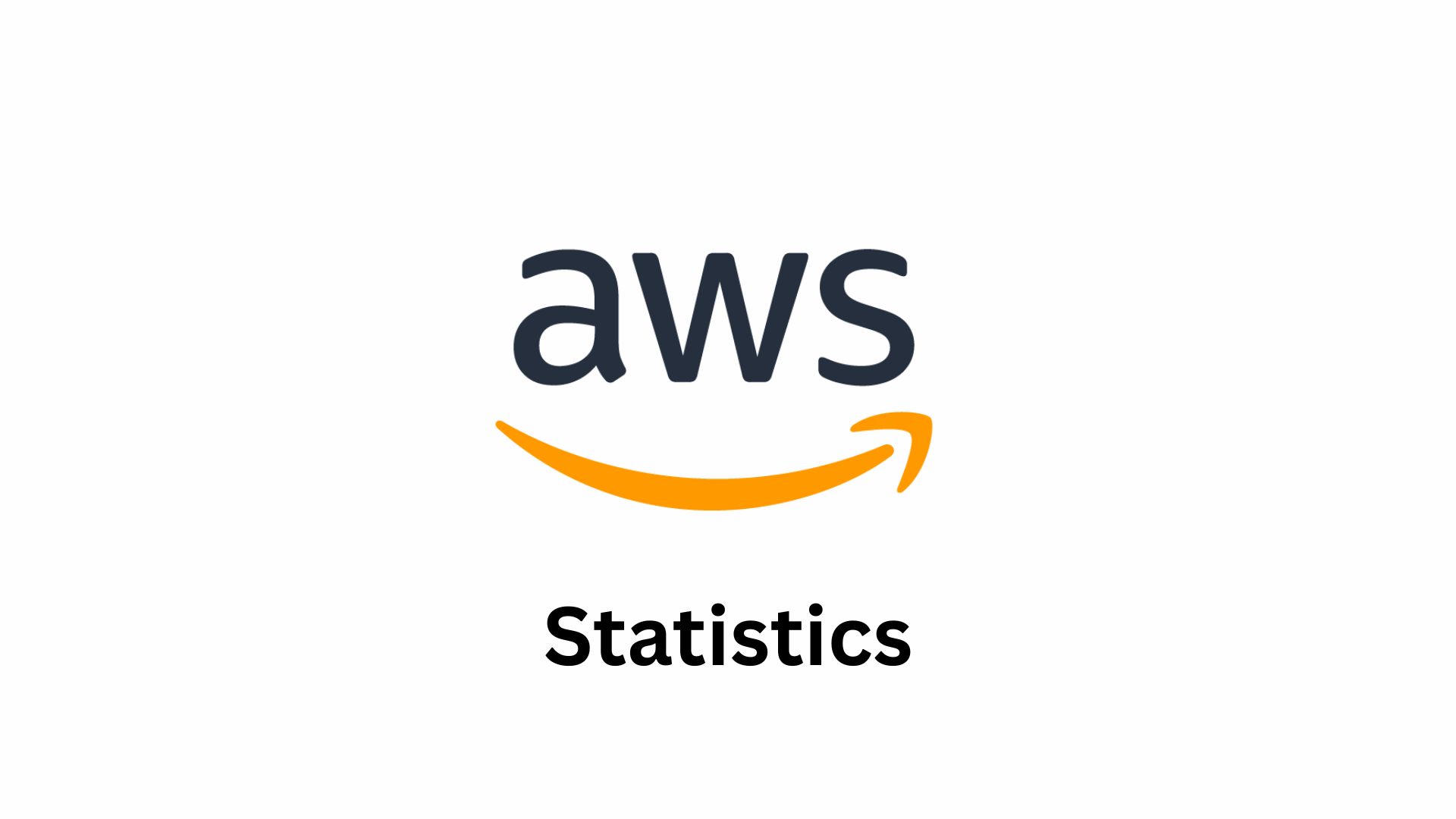
Table of Contents
- Introduction
- Editor’s Choice
- Key Facts
- AWS Year-on-Year Growth
- Quarterly AWS Revenue
- Global Net Revenue Of Amazon By Product Group
- Leading Cloud Infrastructure Service Providers Market Share
- Quarterly AWS TTM Revenue
- Amazon Operating Income/Loss By Segment
- Globally Public Cloud Services End-User Spending
- AWS Usage Statistics
- AWS Features And Infrastructure Statistics
- Conclusion
Introduction
AWS Statistics: AWS is the most complete cloud computing platform, with the most offerings of any cloud provider, with over 200 fully featured services from globally located data centers. Launched in 2006, Amazon’s AWS enables businesses, governments, and individuals to have access to very scalable and cost-effective computing power, storage, databases, AI, machine learning, and security solutions.
AWS is making strong moves around the globe and into various markets, and it continues to be a stronghold in cloud computing. This article focuses on the AWS statistics in the last year, such as revenue, market share, infrastructure investments, and strategy.
Editor’s Choice
- AWS saw a 19% increase in revenue in Q2 2024, the highest growth since 2022.
- In 2023, AWS recorded US$90 billion of net sales from US$80 billion in 2021.
- There are over 175 cloud services from AWS serving varying industries and technologies.
- AWS registered about US$26 billion in revenue from cloud computing and hosting services in Q2 2024.
- Amazon’s total net sales rose to over US$574 billion in 2024 from US$514 billion the year before.
- AWS brought in US$107.56 billion in sales for the year 2024, a substantial contribution alongside US$638 billion in total earnings for Amazon.
- AWS’s market share stood at 30% in the global cloud infrastructure market in Q4 2024, ahead of Microsoft Azure (21%) and Google Cloud (12%). Globally, the cloud infrastructure services spend rose by US$17 billion in Q4 2024, a 22% year-on-year growth, taking the total to US$91 billion.
- AWS in Q2 2024 had revenues of over US$98 billion for the trailing twelve months.
- AWS had an annual operating income of US$24.9 billion in 2024, further reinforcing its position as Amazon’s most profitable segment.
- AWS has more than 1 million active users across start-ups, small businesses, public sector organisations, and enterprises in 190 countries, with 10% being enterprise customers.
- 26.6% of the developers surveyed said they had used AWS services over the previous year.
- AWS manages data centers in various countries and dedicated cloud regions for government use in the U.S. and China.
- AWS infrastructure operates to support thousands of companies in 245 countries and territories, providing twice as many regions as its next closest competitor.
- 64% of cloud users use AWS, with an 85% enterprise adoption rate.
- AWS continues to grow at a fast pace, adding as much infrastructure every day as it did a year back, seven years ago.
- The top five countries visiting AWS in the United States (56.9%), India (18.3%), Japan (14%), the United Kingdom (6.4%), and Brazil (4.3%).
- The global public cloud services market has grown substantially since 2022, worth US$490.98 billion, and is expected to reach US$724.57 billion in 2024.
Key Facts
- Being an online book seller, Amazon has graduated into a global retail leader and technology giant with a suitably important component of its AWS efforts in that success.
- AWS statistics show that by 2024, AWS had grossed more than US$107 billion in net sales revenue, a substantial portion of which went to Amazon’s overall earnings.
- From online to brick-and-mortar retailing, service to third-party sellers, subscription services, AWS, and much more, was included in Amazon’s offerings over the years.
- The increasing worldwide space for cloud services also places AWS into the leading role in retail and cloud levels.
- Such an industry has experienced rapid growth because it is increasingly automated and has turned to be more favorable towards remote work.
- Demand has thus set the likelihood for cloud computing as being one of the best investment opportunities for retail and IT firms.
- In fact, the SaaS market presents more than 19% of annual growth projected in 2025, while the expansion rates for both IaaS and PaaS are close to 25% and 22%, respectively.
- Such projections indicate that in 2025, cloud services will be already accessing US$299 billion for SaaS, US$212 billion for IaaS, and US$209 billion for PaaS revenues.
- And to name a few, among the most prominent hyperscale cloud providers are Amazon, Microsoft Azure, Google Cloud, and Alibaba.
- What they include are technological innovations and a great deal of revenue generation, global reach, and expertise.
- AWS provides an exceptionally wide range of cloud services that may include databases, analytics, management systems, security solutions, IoT, enterprise applications, and development tools.
- The organisation continuously broadens its spectrum of clouds according to revolving customer needs so as to set standards and best practices in the industry.
- Many enterprises depend on AWS as the public cloud platform and infrastructure services to power the applications.
AWS Year-on-Year Growth
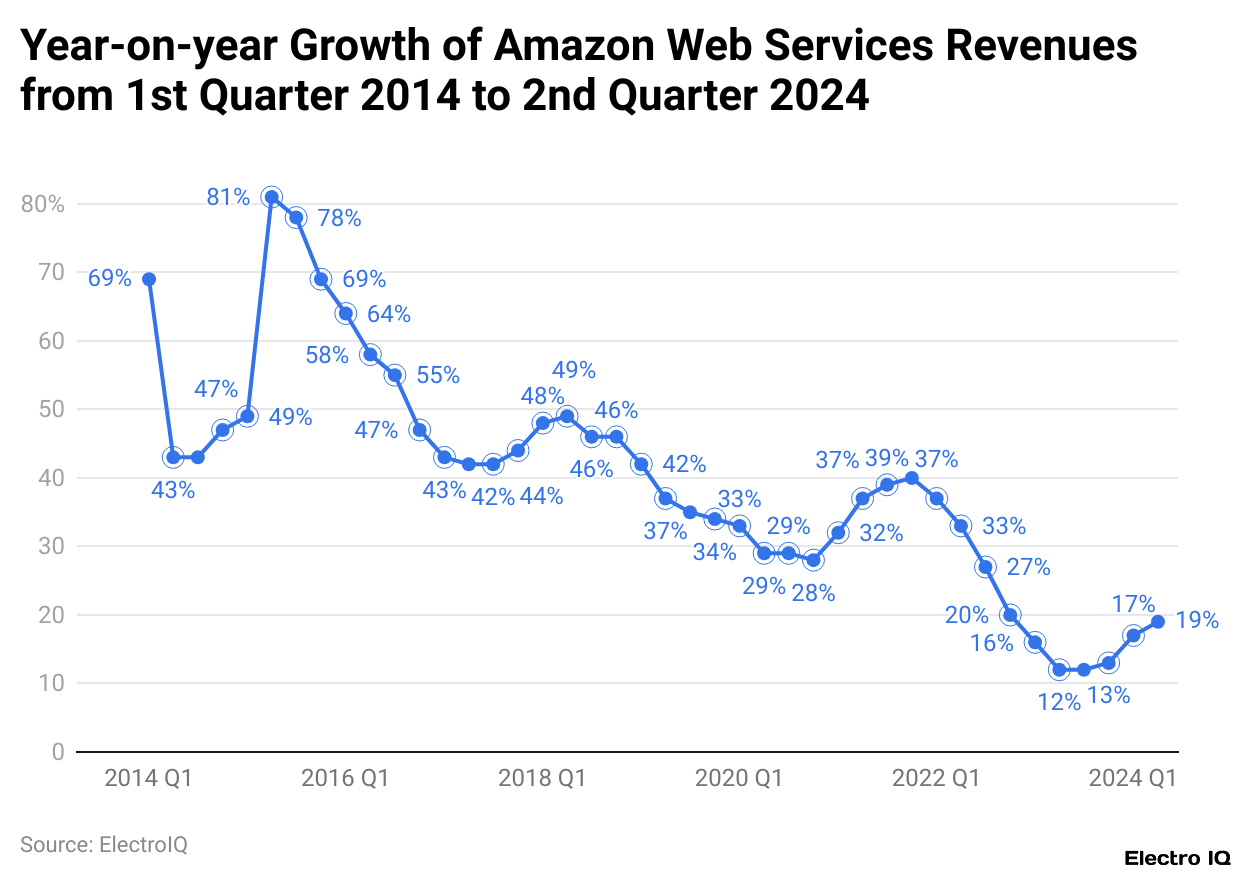
(Reference: statista.com)
- AWS statistics reveal that AWS recorded a revenue increase of 19% in the second quarter of 2024, marking strong development since Q2 of the previous year.
- In 2023, AWS grossed about US$90 billion in net sales, but net sales were just over US$80 billion in 2021; it is one of Amazon’s most profitable segments.
- AWS has a model of on-demand cloud platforms and APIs pay-as-you-go for very different customer paying. It was launched in 2002 concerning general services and tools but started offering the first products in 2006 for the cloud.
- Since that time, the company has grown significantly and now offers more than 175 different cloud services to cover very different industries and technologies.
- As of 2020, AWS has become a major public cloud infrastructure and platform service, beating Microsoft Azure and Google Cloud. Cloud computing is essentially providing online computing services to customers through which a company can store and access data via the Internet without depending on local machines.
- AWS offers all necessary services, such as storage, databases, security, etc., to make a smooth migration as enterprises move applications to the cloud. It also covers a large portion of many renowned companies worldwide, be it Netflix, BBC, or Baidu.
- AWS is now not just a leader in cloud services but also a reliable partner for businesses all over the world due to the vast number of services and growing depth of expertise.
Quarterly AWS Revenue
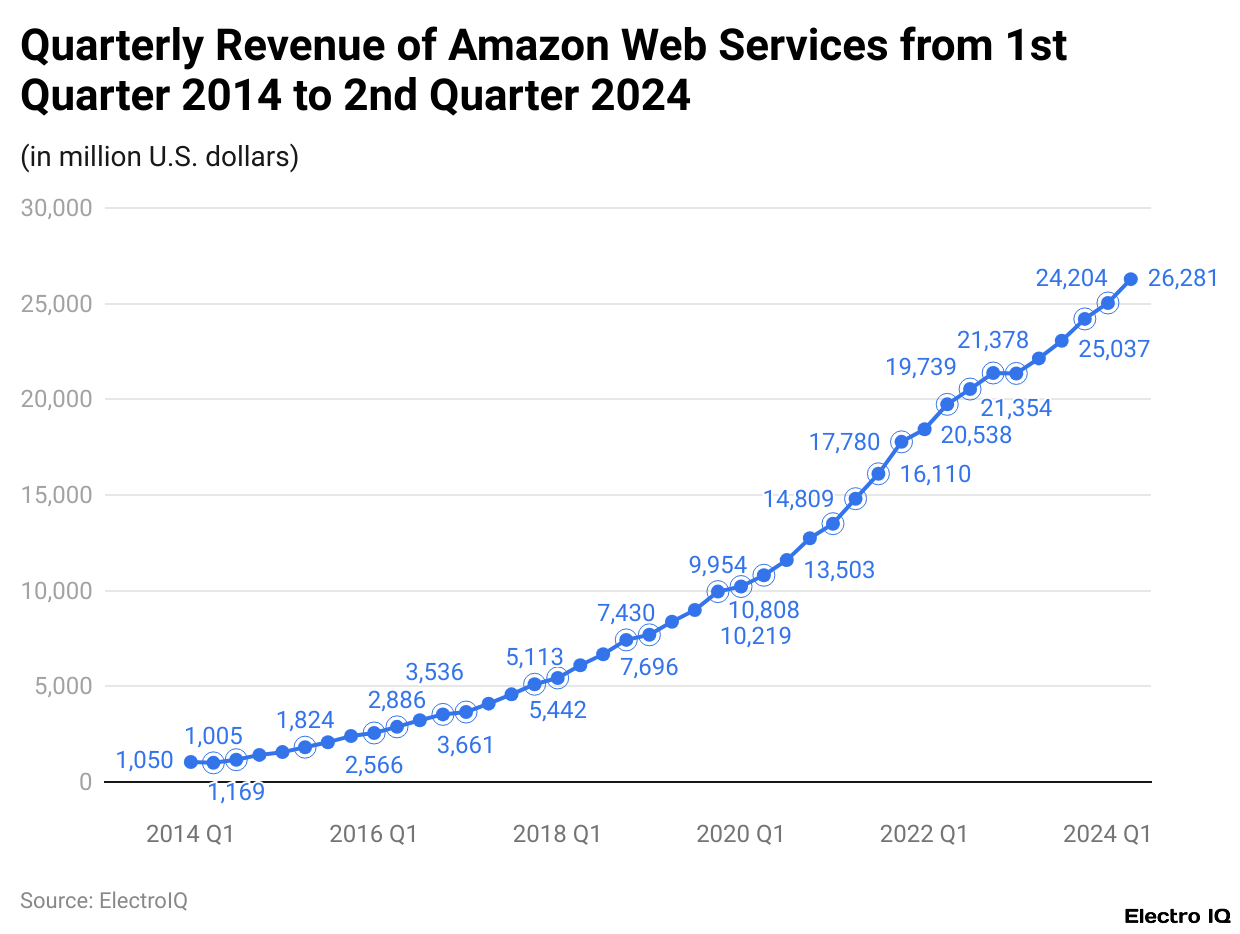
(Reference: statista.com)
- Amazon Web Services is estimated to have earned about US$26 billion in both cloud computing and cloud hosting services in the second quarter of 2024.
- Amazon remains a leading global online retailer and is the top e-retailer in the United States. The company grossed over US$574 billion in net sales in 2024, up from US$514 billion the previous year. Amazon is the world’s largest online retailer that sells everything, including books, clothing, electronics, music, and various consumer items.
- The company is also famous for producing the very much-admired e-reader in the world, the Amazon Kindle. The majority of Amazon’s revenue comes from the sale of electronics and other consumer products, followed by revenue from third-party seller services and Amazon Web Services.
- Amazon primarily deals with B2C but also helps third-party sellers through a platform where they sell their products. The company also sells technological infrastructure services through AWS, which are delivered to different businesses around the world. As of the second quarter of 2024, over 50% of paid units sold on Amazon came from third-party sellers.
- AWS cloud computing and hosting services represent a fast-growing area within online enterprise solutions.
- AWS statistics show that being one of the most well-consumed public cloud platforms, AWS still leads the competition.
- In a survey conducted globally, 76% of respondents reported that they were already running applications on AWS. Competitors include other major cloud service providers like Microsoft (with Azure), Google, Oracle, and IBM.
Global Net Revenue Of Amazon By Product Group
| Characteristic | Online stores | Physical stores | Retail third-party seller services | Subscription services | AWS |
| 2014 | 68.51 | – | 11.75 | 2.76 | 4.64 |
| 2015 | 76.86 | – | 16.09 | 4.47 | 7.88 |
| 2016 | 91.43 | – | 22.99 | 6.39 | 12.22 |
| 2017 | 108.35 | 5.8 | 31.88 | 9.72 | 17.46 |
| 2018 | 122.99 | 17.22 | 42.75 | 14.17 | 25.66 |
| 2019 | 141.25 | 17.19 | 53.76 | 19.21 | 35.03 |
| 2020 | 197.35 | 16.23 | 80.46 | 25.21 | 45.37 |
| 2021 | 222.08 | 17.08 | 103.37 | 31.77 | 62.2 |
| 2022 | 220 | 18.96 | 117.72 | 35.22 | 80.1 |
| 2023 | 231.87 | 20.03 | 140.05 | 40.2 | 90.76 |
| 2024 | 247.03 | 21.22 | 156.15 | 44.37 | 107.56 |
(Source: statista.com)
- In 2023, revenues accrued from Amazon’s subscription base services attained a record high of US$44.37 billion.
- Amazon Prime counts among the services under this segment and recorded 200 million paying members by the end of 2020.
- AWS statistics state that the division generated annual sales of US$107.56 billion. Overall, Amazon’s total net revenues amounted to US$638 billion over the last reported fiscal year. With consistent revenue growth, Amazon is one of the largest online firms worldwide.
- Indeed, Amazon registered a 21% increase in revenue during the year that saw Google achieve 18% revenue growth in the same period. Most of the net sales of the company are generated through its North American business segment, which accounted for US$236.3 billion in 2020. The United States houses approximately 76% of the global population within Amazon’s market, followed by Germany and then the United Kingdom.
- An example of the fastest growing segment in Amazon’s business is AWS. As a cloud computing service, AWS provides all computing, network, storage, database, analytics, and application services for private persons, enterprises, and governments.
- By the end of 2020, AWS covered about 32 percent of the total global market for cloud infrastructure services, further consolidating its position as the industry leader.
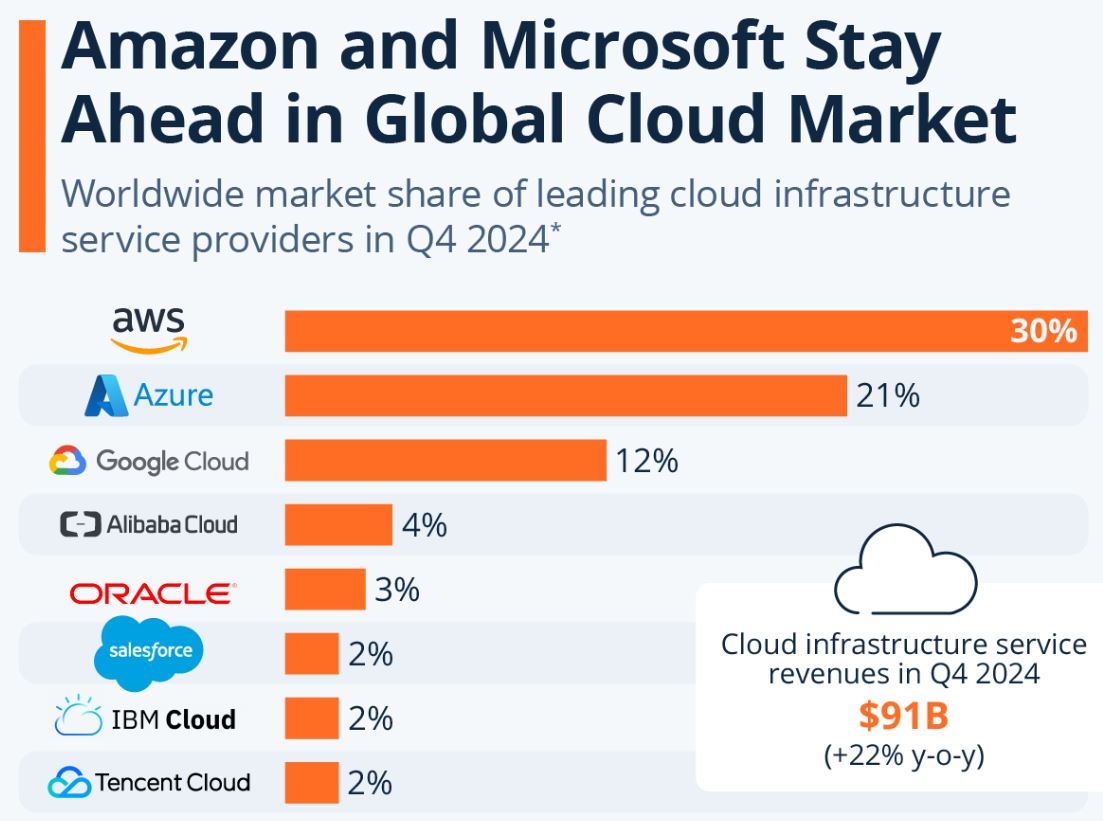
(Source: statista.com)
- Amazon Web Services (AWS), the online retail behemoth’s most lucrative cloud platform, has continued to reign as the undisputed king of the market for cloud infrastructure.
- According to AWS statistics from Synergy Research Group, by the fourth quarter of 2024, AWS had gained a 30% share of the worldwide cloud infrastructure market to stay well ahead of Microsoft Azure, which had 21%, and Google Cloud, with a 12% share.
- In fact, those three giants together controlled over 60% of the fast-evolving cloud market, while all the rest simply floundered below the low single-digit percentage range.
- Global spending on cloud infrastructure services grew by US$17 billion during the fourth quarter of 2024, representing a 22% increase from the same period last year. That brought the total seasonal revenue to the December 31, 2024, figure of US$91 billion.
- Cloud infrastructure service revenues reached an impressive US$330 billion for the full year, underscoring the highly competitive nature of this industry.
- AWS statistics showed a sharp increase in net spending by people in 2024.
- The cloud space has proven its growth prowess through impressive period-on-period sales growth rates throughout the year. John Dinsdale, chief analyst at Synergy Research Group, captured the positive state of the market by stating that the growth wave has been phenomenal and impressive, especially for an industry of such massive size.
- The introduction of AI-oriented services and technologies establishes a positive feedback loop—new capabilities generate demand, which leads to revenue growth, which enables investment in more technology. This is expected to continue driving further growth in the cloud market for years to come.
Quarterly AWS TTM Revenue

(Reference: statista.com)
- AWS statistics reveal that in the second quarter, trailing twelve-month revenues at Amazon Web Services (AWS) exceeded US$98 billion. AWS includes a variety of computing platforms and APIs that businesses and individuals can call upon as they need them.
- It allows its customers to deliver, store, and power applications, as well as use mass storage for databases in other cloud-based methods.
- This means that customers can have a much smaller on-site infrastructure package while still managing and scaling their digital operations cost-effectively.
Amazon Operating Income/Loss By Segment
| Characteristic | North America | International | AWS |
| 2014 | 360 | -640 | 458 |
| 2015 | 1,425 | -699 | 1,507 |
| 2016 | 2,361 | -1,283 | 3,108 |
| 2017 | 2,837 | -3,062 | 4,331 |
| 2018 | 7,267 | -2,142 | 7,296 |
| 2019 | 7,033 | -1,693 | 9,201 |
| 2020 | 8,651 | 717 | 13,531 |
| 2021 | 7,271 | -924 | 18,532 |
| 2022 | -2,847 | -7,746 | 22,841 |
| 2023 | 14,877 | -2,656 | 24,631 |
| 2024 | 24,967 | 3,792 | 39,834 |
(Source: statista.com)
- In the annual report for 2024, AWS spoke about an annual operating income of nearly US$24.9 billion, marking a rise from the past fiscal year. It is well known as a retail giant, but it is highly capitalised from the segment of its business known as cloud computing- AWS.
- AWS is also the cloud provider for other massive technology corporations such as Netflix, Adobe, Sony, and X, among others.
- AWS statistics show that even though AWS makes billions, Amazon fights with many other sectors of its business. Over the last three years of business, the multinational segment has accumulated losses in its profit resulting from international sales.
- According to Amazon, “This is primarily due to a financial risk originating from operating in global markets”. Business in North America bears with a variety of laws and regulations by the government of the continent, competitiveness from other regional players, and logistics management for areas where progress in infrastructure is slow.
- The most difficult countries are usually given to Amazon: India, which also includes China. Revenue from India is now around 222 billion rupees, or roughly US$2.6 billion, coming in from net sales by Amazon in that country. It has gone broad and outpaced a lot of other market competition. Nonetheless, it continues to be probed by regulators, as well as trade unions, on the subject of the conditions of work in Amazon warehouses, along with that of market competition.
- Increased scrutiny has been almost without exemption focused on the labor practices of the company and has rather raised the stakes in a rapidly growing but quite highly regulated market.
Globally Public Cloud Services End-User Spending
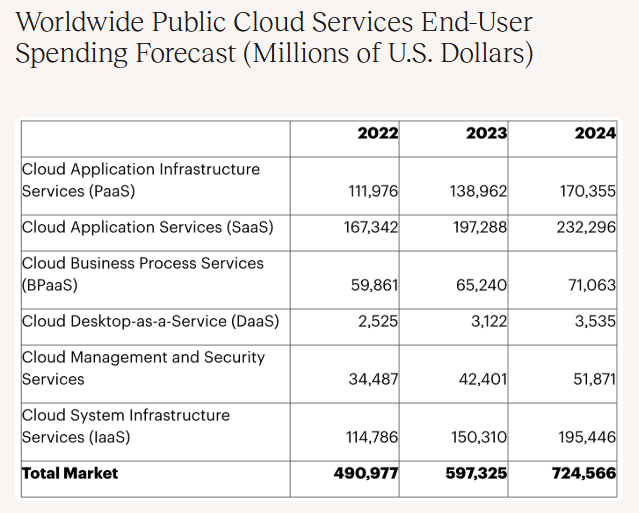
(Source: kinsta.com)
- Public cloud services – end-user expenditure globally maintained an upward trajectory across different segments between 2022 and 2024.
- Cloud Application Infrastructure Services (PaaS) registered an increase in spending from US$111.98 billion in 2022 to US$138.96 billion in 2023 and further growth to US$170.36 billion in 2024. Cloud Application Services (SaaS) have recorded some gradual growth, moving from US$167.34 billion in 2022 to US$197.29 billion in 2023 and further to US$232.30 billion in 2024.
- Spending has risen steadily in Cloud Business Process Services (BPaaS), which rose from US$59.86 billion in 2022 to US$65.24 billion in 2023 and US$71.06 billion in 2024.
- The Cloud Desktop-as-a-Service (DaaS) market is still quite young but grew from US$2.53 billion in 2022 to US$3.12 billion in 2023 and will reach US$3.54 billion in 2024.
- Cloud Management and Security Services had a steady growth pattern, with end users spending US$34.49 billion in 2022, US$42.40 billion in 2023, and US$51.87 billion in 2024.
- Another with the highest growth in spending was the Cloud System Infrastructure Services (IaaS), which moved from US$114.79 billion in 2022 to US$150.31 billion in 2023 and climbed to as high as US$195.45 billion in 2024.
- In total, therefore, while increased spending on public cloud services by consumers or private organisations and agencies has been recorded almost everywhere, the global public cloud services market experienced significant growth: from US$490.98 billion in 2022 to US$597.33 billion in 2023 and US$724.57 billion in 2024.
- This steady upward progress signifies that business organisations worldwide across different sectors are increasingly becoming dependent on clouds for their operations, infrastructure, security, and applications.
AWS Usage Statistics
- AWS statistics state that Amazon Web Service (AWS) has a pretty large user base, which currently consists of more than 1 million active users spread across 190 countries.
- 10% of these are enterprise customers, while most others are small to medium-sized businesses. Among developers, this platform remains one of the top choices, with 26.6% of software developers stating that they have used AWS services in the last 12 months. AWS conducts its business through a vast number of data centers in different countries: the United States, Canada, France, Germany, Ireland, the United Kingdom, India, Japan, Singapore, South Korea, Sweden, and Brazil.
- AWS also has separate cloud regions for the U.S. government and has developed two separate regions to serve customers in China.
- The AWS infrastructure supports thousands of businesses in 245 countries and territories, being in twice the number of regions as its nearest competitor.
- Among enterprises using cloud services, 64% use AWS, while within the enterprise segment, AWS adoption is at 85%.
- A sizable share of AWS traffic comes from the U.S., accounting for 56.9% of visits, followed by India at 18.3%, Japan at 14%, the United Kingdom at 6.4%, and Brazil at 4.3%.
- AWS is growing its infrastructure at a fast rate and probably today is adding capacity every single day which it would have added in a year about seven years ago.
AWS Features And Infrastructure Statistics
- AWS statistics show that since 2023, the recognised leader among Strategic Cloud Platform Services, AWS remains committed to providing secure and automated cloud solutions to businesses.
- Out of 1 million clients, AWS handles clients coming from 190 countries, reflecting the well-deserved trust from their customer base and AWS technologies on the delivery of the best cloud services.
- AWS homes a global infrastructure of immense capacity with 105 Availability Zones spread over 33 Geographic Regions, with plans for the addition of 18 Availability Zones and six new Regions in Malaysia, Mexico, New Zealand, Saudi Arabia, Thailand, and the AWS European Sovereign Cloud.
- AWS is witnessing significant data transfer growth, with an increase of 12.4% year on year, suggesting that an increasing number of businesses rely on AWS for safe and efficient data movement.
- AWS offers the most cost-efficient cloud solutions, reducing infrastructure costs by 45% compared to other vendors.
- The Application Load Balancer manages more than 400 billion requests per week, ensuring seamless and scalable traffic management to various web applications.
- Over 100,000 companies, ranging from startups to the Fortune 500, apply AWS machine learning to innovate and solve problems.
- Furthermore, AWS S3 is a storage giant that has lifted 100 trillion objects and does millions of requests per second.
- The AWS solution provides enterprise-strength credibility, with 80 percent of SAP HANA public cloud service customers preferring it.
- AWS has also established its dedication to sustainability by launching 22 wind and solar projects worldwide since 2021.
- With more than 310 renewable energy projects, AWS produces 10,000 megawatts in capacity and feeds over 29 million megawatt-hours of renewable energy. AWS aims to run entirely on renewable power by 2025.
- This includes almost 2,000 government agencies, 5,000 educational institutions, and over 17,500 non-profits. In addition, over 7,500 such U.S. government agencies rely on AWS for their cloud needs, leveraging its strength on security, agility, and cost-effectiveness.
- It continues to grow its cloud infrastructure, adding in a single day enough computing power to run a Fortune 500 company.
- It has five times more cloud infrastructure than the next 14 competitors put together. The platform is also a key player in web hosting, with over 50 million websites hosted worldwide, around 9 million of which are live sites hosted on AWS.
- Together, these account for 6.2% of all websites in the world. AWS’s site is a very busy place, where it garners about 60 million visitors a month.
- Comparatively, Amazon’s online store can boast of having about 197 million visitors monthly. The largest contributor is the United States, with 37.74% of AWS web traffic, followed by India at 10.83% and Japan at 6.30%.
- According to AWS statistics, a major portion of this traffic is direct- 52.69%- while 29% comes from organic search and 9.88% are through referrals.
Conclusion
As per AWS statistics, AWS displayed strength and fortified its leadership in the cloud computing industry. Massive revenue growth, significant market share, and proactive investments in infrastructure and AI technologies exemplify AWS’s commitment to innovation and customer satisfaction. As AWS works its way through regulatory difficulties and community relations, sustainable and responsible growth will be paramount in determining the direction of its future.
Sources
FAQ.
In 2024 made a whirlpool of US$107.56 billion in annual sales. Substantial revenue from AWS that year further underpinned Amazon’s total revenue of US$638 billion. This shows steady growth since US$90 billion in 2023 and US$80 billion in 2021. Hence, the constant snowballing demand for cloud computing continues.
In the fourth quarter of 2024, AWS had a global cloud infrastructure market share of 30%, maintaining a lead over both Microsoft Azure at 21% and Google Cloud at 12%. Operating in concert, the three have control over more than 60% of the cloud market.
There are more than 1 million active users of AWS in 190 countries, with 10% being enterprise customers. On the other hand, 64% of enterprises using cloud services are reliant on AWS, whereas 85% of enterprise organisations have embraced AWS services.
With a stipulated addition of 18 more Availability Zones and six new Regions in Malaysia, Mexico, New Zealand, Saudi Arabia, and Thailand alongside the AWS European Sovereign Cloud, AWS conducts 105 Availability Zones in 33 Geographic Regions. The expansion of AI-augmented cloud services, with a focus on the immediate demands of the industry, was also one of the more significant service expansions in 2024.
AWS is still the most profitable of Amazon’s businesses, with an operating income of US$24.9 billion in 2024. The segment continues to bring in significant revenues that support some huge clients globally, including Netflix, Adobe, Sony, and thousands of other businesses, despite the international retail arm of the business facing challenges.

Barry Elad is a passionate technology and finance journalist who loves diving deep into various technology and finance topics. He gathers important statistics and facts to help others understand the tech and finance world better. With a keen interest in software, Barry writes about its benefits and how it can improve our daily lives. In his spare time, he enjoys experimenting with healthy recipes, practicing yoga, meditating, or taking nature walks with his child. Barry’s goal is to make complex tech and finance information easy and accessible for everyone.










